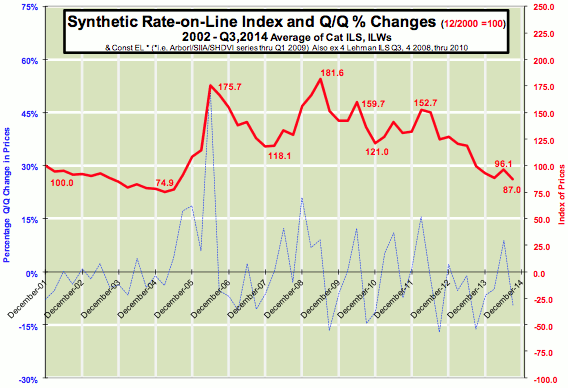The pace of decline shown by insurance-linked securities and catastrophe bond premiums or rates has accelerated through the third-quarter of 2014, plunging to new lows, according to the latest analysis from ILS consultancy Lane Financial LLC.
Lane Financial’s synthetic rate-on-line index, which uses data from both the ILS and ILW markets to give a reasonable approximation of premiums being paid (or rate-on-line) for ILS and cat bond transactions, has witnessed a general declining trend since early 2012.
The rate-on-line index actually bounced back slightly in the second-quarter of this year, but the latest report published on Friday by Lane Financial shows that after yields rose just before the U.S. hurricane season they have since, in the words of Lane Financial, “Plunged to new lows.”
As you can see from the chart below, reproduced from the Lane Financial Q3 market performance report, the synthetic rate-on-line index dropped by approximately 9.5%, from 96.1 at the end of Q2 down to just 87 by the end of Q3. The index has now declined by 43% since early 2012, perhaps reflecting the maturation of the ILS space, as well as softening trends, as ILS capital explored its ability to be deployed at ever lower levels of return.

Lane Financial LLC ILS Synthetic Rate-on-Line Index and Q/Q % Changes - Source: Lane Financial
Lane Financial explains in the report:
The Index is based on changes in quote sheet yields for all non‐impaired ILS that have a significant remaining risk period. It is also based on observations from the ILW market and a “constant expected loss” yield. While far from perfect and certainly not a tradable index, we have maintained that consistently applied it gives a valuable insight into changes presently underway in the catastrophe reinsurance and insurance market. It provides a heads‐up to cedents and assumers of risk prior to traditional renewal times. It shows whether the market is softening or hardening and by how much. This quarter the verdict is that the market continues soft.
In fact, looking at the chart which denotes whether we are currently seeing a soft ILS and catastrophe bond market makes it very clear that market pricing has been declining since early 2012 and the ILS market has been technically soft since the second half of that year.
The softness was at its most pronounced in the latter part of 2013 and early 2014, after which prices have hardened slightly but in the third-quarter of 2014 Lane Financial’s analysis shows the softening picked up again.

Discount of premium of the ILS and catastrophe bond market - Source: Lane Financial
What does this mean for the upcoming renewals for catastrophe reinsurance pricing and for any catastrophe bonds that come to market through the rest of 2014 and into early 2015?
It suggests that ILS and cat bond prices will remain soft and that the buyers market conditions are likely to remain right through the end of this year and more than likely into 2015, unless any losses or market conditions affect sentiment and pricing.
For sponsors of catastrophe bonds this is good news, signifying that attractive pricing and likely terms will be available from the market again this year through the fourth-quarter. The opportunity will be available for cedents to push increasing volumes of risk into the cat bond market, if they should choose, as with capital levels high and many ILS managers able to raise more capital to support deals at short notice there could be unprecedented demand for new cat bond issues.
For the traditional reinsurance market this suggests that either they will need to be prepared to match pricing on cat bonds and ILS or walk away from some transactions, allowing the ILS market to take them on. Reinsurers can expect continued pressure on pricing if the market softness persists through into 2015, something which is broadly expected to occur.
The one issue that this hard/soft market chart does not perhaps reflect, is the understanding of cost-of-capital and return expectations in the ILS space. One possible reason that ILS prices have softened so much is that ILS investors have largely gained an appreciation of just how low the return required for assuming certain levels of risk can be. So what appears to be a very soft market could actually only be slightly soft, if the pricing and return expectations among investors and ILS managers have changed materially in the last two years.
That brings up a very interesting question. If the market is only slightly soft for ILS capital but is very soft for traditional reinsurance capital, due to differences in cost and their abilities to deploy capacity at low-levels, how long could reinsurers continue to compete with this mismatch in return expectation?
As ever the Lane Financial report provides excellent analysis of pricing and returns of the outstanding ILS and catastrophe bond market. This quarter also explores the newly emerged transparency in secondary ILS pricing thanks to FINRA’s TRACE system. You can download a copy of the full report via the Lane Financial website here.
 View all of our Artemis Live video interviews and subscribe to our podcast.
View all of our Artemis Live video interviews and subscribe to our podcast.
All of our Artemis Live insurance-linked securities (ILS), catastrophe bonds and reinsurance video content and video interviews can be accessed online.
Our Artemis Live podcast can be subscribed to using the typical podcast services providers, including Apple, Google, Spotify and more.































